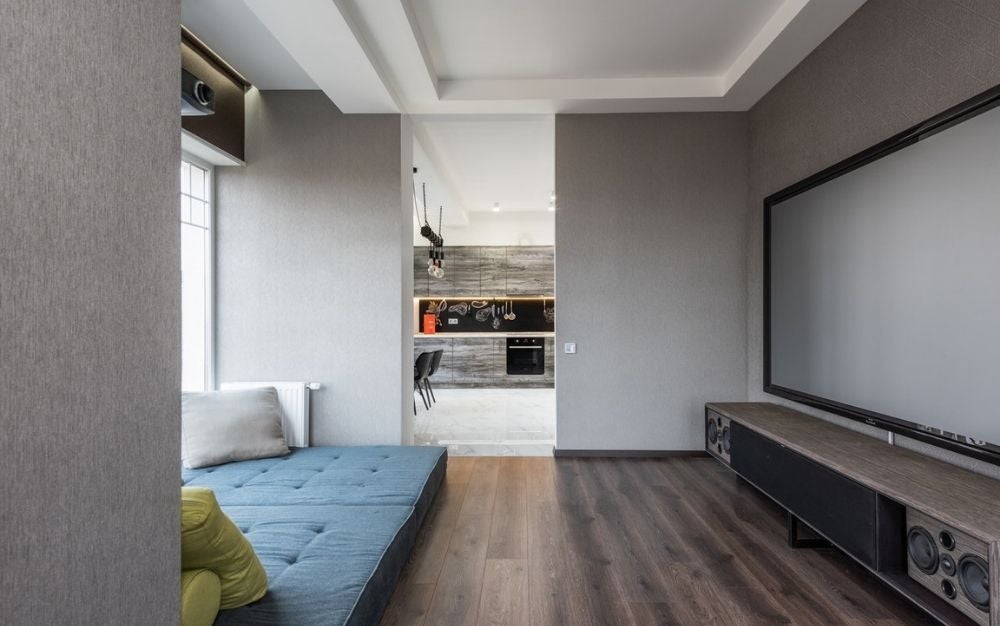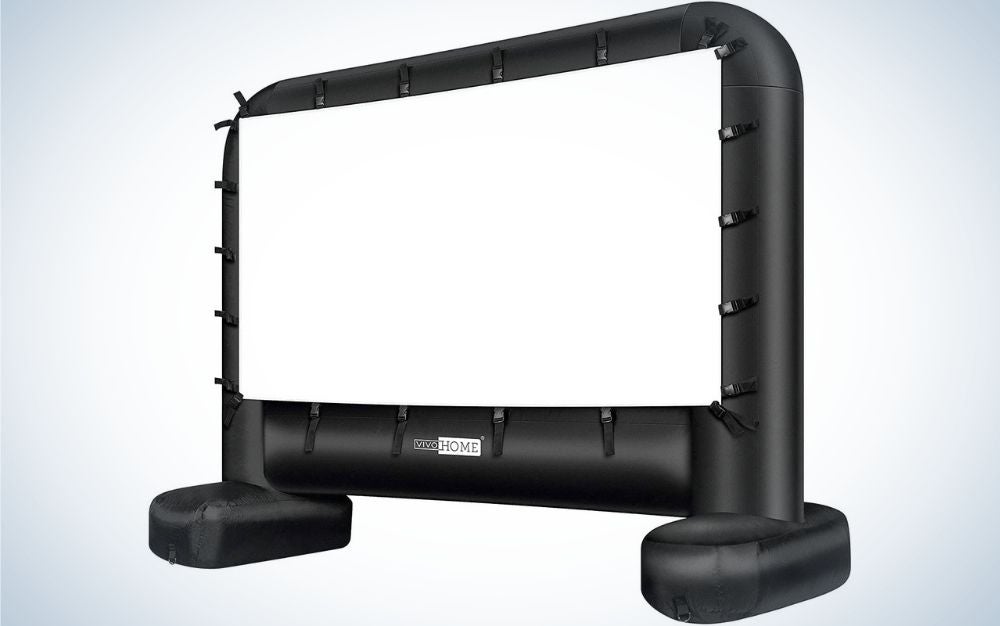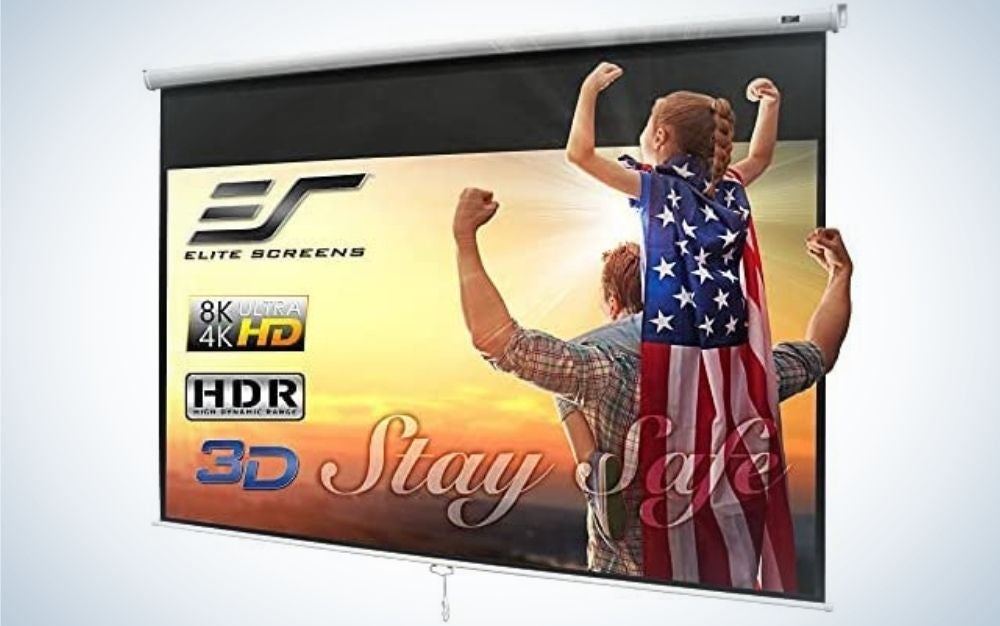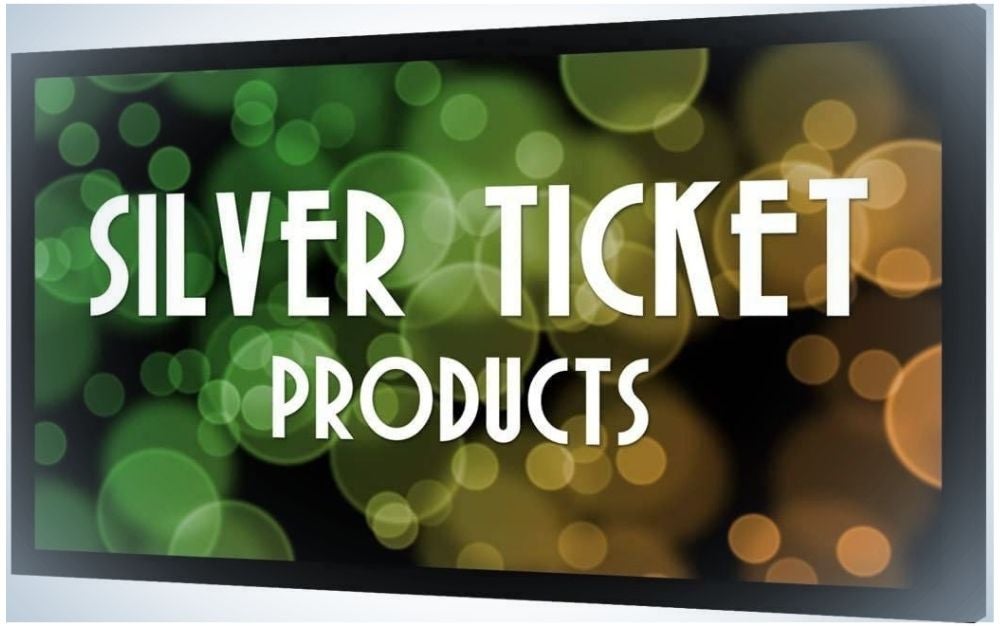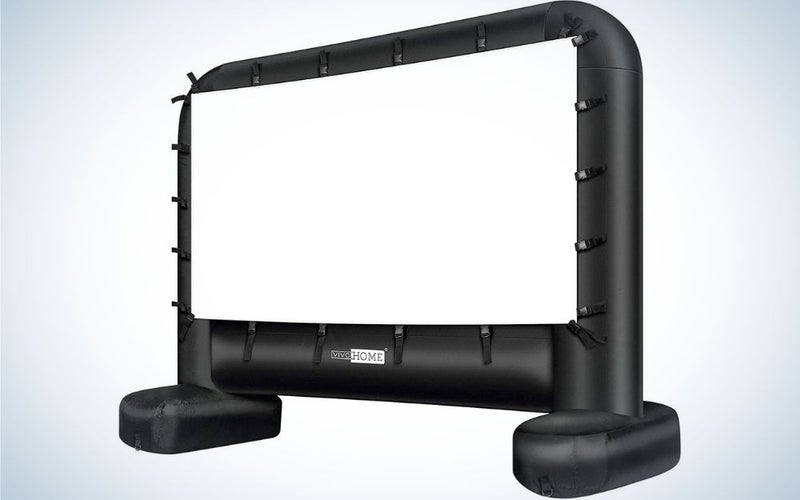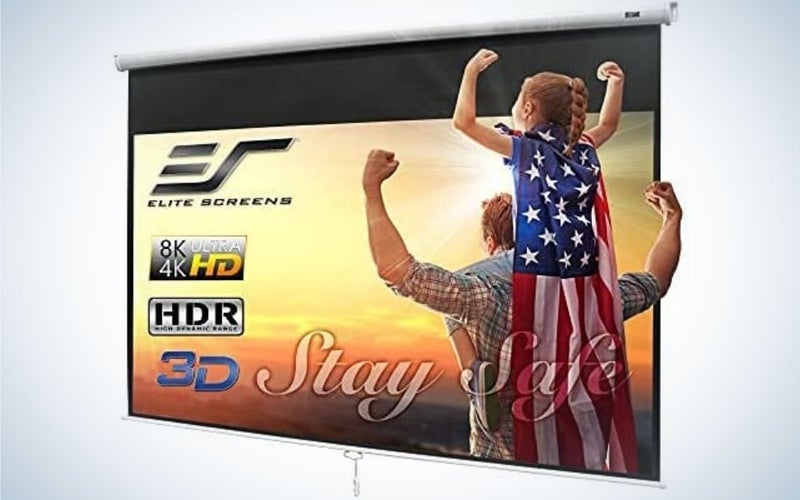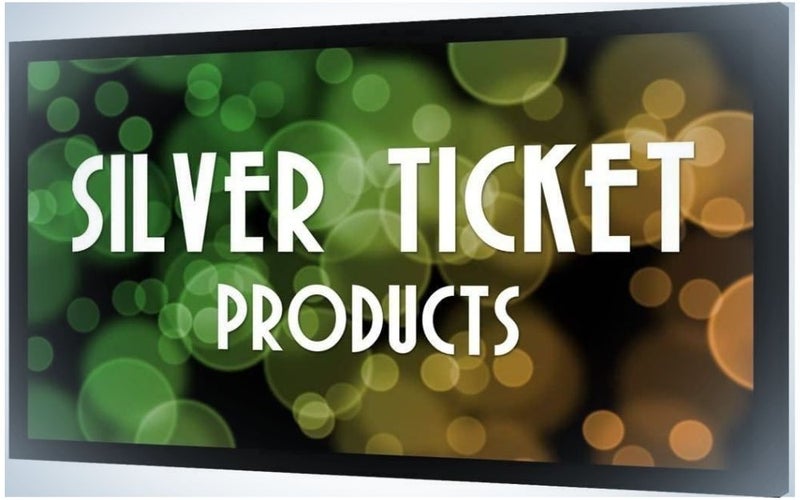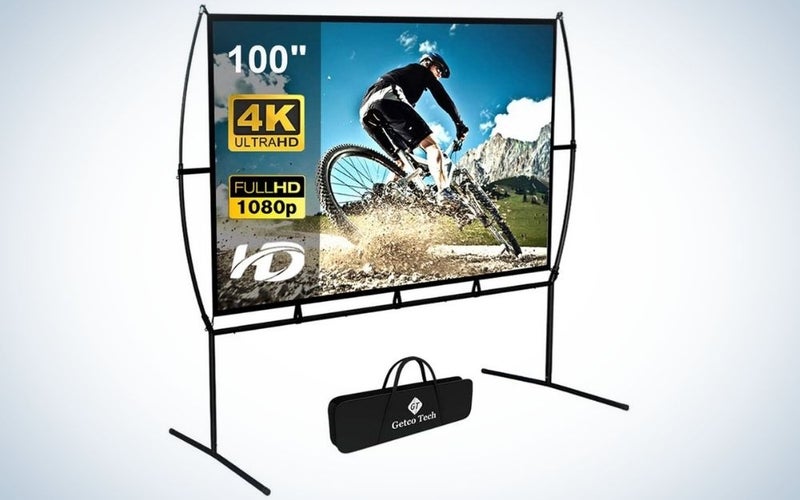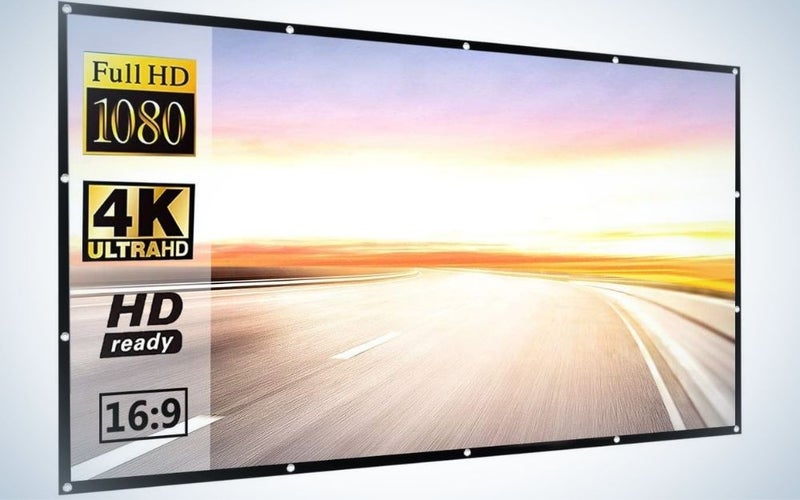We may earn revenue from the products available on this page and participate in affiliate programs. Learn more ›
For the true home theater experience, you need more than a white sheet taped to the wall—you need not only the best projector, but a dedicated movie screen with the reflective power to show off HD movies, photos, and PowerPoint slides. Video screens come in a wide variety of styles and sizes. From big inflatable projector screens that fill up the backyard to portable pull down screens that turn any room of the house into a personal movie palace, the right screen is an affordable way to add a professional wow-factor anywhere it’s dark.
Today’s home theater screens are affordable and user-friendly. Raise the movie theater screen. Turn on the wall projector. Pop the corn. And get ready to experience “Jumanji: Welcome to the Jungle” as it was intended to be seen—on the big screen.
- Best for outdoor movies: VIVOHOME 14 Feet Indoor and Outdoor Inflatable Blow up Mega Movie Projector Screen
- Best for first time users: Elite Screens Manual B 100-INCH Manual Pull Down Projector Screen
- Best for home cinema: Silver Ticket Products STR Series 6 Piece Home Theater Fixed Frame
- Best portable projector screen: GT Foldable Projector Screen with Stand
- Best projector screen under $25: P-Jing Projector Screen 120 inch
What to consider when shopping for the best projector screen
Not all screens are perfect for all environments. Some screens only thrive in total darkness, while others are designed for the typical living room setup. Plus, some need more assembly time than others. Learn what makes these home theater screens shine and find the best projector screen for your home, backyard or office.
The two types of home movie screens
When shopping for a new home movie screen, you’ll be looking at two main types: permanent and portable. As the name implies, permanent screens stay in one place and stay flat. Fixed frame screens are like traditional movie theater screens. The reflective material is stretched properly across the metal or plastic frame to maintain optimal flatness. They don’t fold or roll up, eliminating creases.
Pull-down permanent screens work like window shades, but the mechanisms have come a long way since the days of shades that snap up unexpectedly. And a motorized projector screen slowly rises out of furniture or ceilings like a stalking vampire. Both pull-down and motorized screens are great for those who lack the space needed for a large home theater.
For portable screens, you can choose a screen attached to a foldable stand or an inflatable screen for outdoor use. These will be less expensive than permanent screens and easy to use, but transporting can take a toll on the delicate screen material. And inflatable screens need a running fan to keep the screen supported, which can distract from a quiet movie or presentation.
What is gain and why is it important?
Gain refers to the ratio of light coming out of the projector to the light that bounces off the screen and into your eyes. A home movie screen with a gain of 1.0 displays the image on the screen at the same brightness that the light is leaving the projector.
But a screen with a gain higher than 1.0 will reflect the image brighter than it’s being projected. For instance, a screen with 2.0 gain will take a 1,000 lumen light source from a projector and turn it into 2,000 lumens of light bouncing off the screen. Screens with higher gain are designed to focus the light hitting the screen—instead of the light bouncing all over the room, the light is aimed to the middle of the screen. Screens with higher gains look great and bright if you’re sitting directly in front of the screen, but those sitting at an angle won’t see such brightness.
The screen material color options of projector screens
The color of the projector screen makes a difference, and in more ways than you think. Projector screens come in three colors: white, gray and black. While you want it to be reflective, you want it to reflect only the projected images, not all the ambient light.
Gray is best for showing movies and watching videos where ambient light can be a factor, such as most rooms in the house or outdoors. They are good all-around projectors, but the images can have a slight grayish tone.
White screens are great for rooms without any other sources of light, such as a dark conference room or home theater. White screens also make text a bit more legible, which is another plus if you’re looking for a work screen to use during presentations. But the white screen loves to bounce back any and all light, so even a little sunshine sneaking in through the window can blow-out the image.
Black screens are better at showing deep, dark blacks, obviously. Their dark contrast can also make bright colors appear more vivid. But black screens can create a rainbow effect around bright images. And the screen may have hot spots or brighter patches of light that can be fixed with meticulous adjustment of your projectors—which can be a pain.
Understanding screen size and viewing angle
For true audio-video enthusiasts, screen placement and size is a complicated matter that requires calculations and a doctorate degree in trigonometry. But there are a few rules of thumb to help even the amateur movie watcher achieve great looking images on the video screen.
First, let’s talk about height. You want the screen to be at least two feet off the ground (or higher, if this is a home theater with multiple rows of seats). You also need about a foot of space between the ceiling and the top of the screen so viewers aren’t straining their necks to look up. Look at the wall or space you plan to use the screen. If you need at least 2 feet of floor room and 1 foot of ceiling room, take the actual height of the room and subtract 3 feet. That gives you a good place to start for screen height.
For width, it depends on the aspect ratio you plan to use most. For a 4:3 aspect ratio (a more square screen like that of old TVs and TV projectors), multiply the height by 1.33 to get a rough width estimate. For 16:9 aspect ratios (a more cinematic, wide-screen look), multiply the height by 1.8 for a good width.
The best seat in the house will be about double the width of the screen. If the screen is 80 feet wide, the optimal viewing distance will be 160 feet from the screen. Most screens have an optimal viewing angle of 30-degrees, but this can vary based on room conditions and ambient light.
If you already own a projector, look at the specs. They should tell you proper projector placement and aspect ratio.
What is a rear projector screen and do you need it?
A rear projector shines the image through the back of a rear projector screen. The projector is set up behind the screen. Why would you want such a setup? First, it prevents shadows. It can also be quieter to stash the projector behind the screen, especially if your projector has a loud fan. Rear projector screens are also great for those with unique and limited space.
Rear projector images are just as bright as a front projector. And many projector screens can be used for both rear and front projectors.
The best projector screens
Ready to expand your worldview with a projector screen? You’ll notice many screens advertise similar stats and features, but look at the material type and durability. And make sure you understand how the screen is set up to avoid frustration during installation or anxiety moments before a big presentation. Find the best projector screen for your needs and your space.
Best for outdoor movies: VIVOHOME 14 Feet Indoor and Outdoor Inflatable Blow up Mega Movie Projector Screen
VIVOHOME
The benefit of a great inflatable outdoor projector is convience. The VivoHome 14-feet inflatable movie projector is ready to go in a few minutes and is the best projector screen for outdoor movies. The fan isn’t 100 percent silent, but it’s not as noticeable as other inflatable screens. It requires a bit of wrangling and maneuvering to get the screen flat and upright, but that’s to be expected of any inflatable outdoor projector screen.
This isn’t designed for 4K resolution—outdoor projectors are not known for their high-resolution thanks to ambient light and the pesky glow of the moon. Even with all that in mind, the movie projector screen is bright and shows off an impressive display of color. If you want an outdoor screen for watching sports or entertaining the kids, this screen is a solid pick for the backyard or an outdoor event.
Best for first time users: Elite Screens Manual B 100-INCH Manual Pull Down Projector Screen
Elite Screens
The Elite Screens Manual B screen is a basic and beautiful video screen. The pull-down projector screen is easy to install and the pull-down/roll-up mechanics are smooth and sturdy. The 100-inch screen displays vibrant colors on its white surface and doesn’t bounce back too much ambient light. The material can show off 4K video in a dark room. The 1.0 gain screen is bright and offers a nice, wide viewing angle so people sitting off to the side can still see the screen clearly.
This is an entry-level product, so those with more home theater experience may want a movie theater screen with better gain and higher-quality materials. But for first-timers, this is the best projector screen for movies, football, and gaming.
Best for home cinema: Silver Ticket Products STR Series 6 Piece Home Theater Fixed Frame
Silver Ticket Products
Fixed frame screens can seem intimidating to install, but the Silver Ticket screen is easy to attach to a wall with a few screws and is the best projector screen for home cinema. The screen itself offers a sharp, clear picture with intense colors and rich, dark shadows. You can choose the color of the screen—white, gray/silver, or high contrast black. If the room is dark and you use blackout curtains, the screen color won’t matter much, but the gray/silver is a safe bet for most environments where a little ambient light is expected. Movies with an aspect ratio of 16:9 look great on the 92-inch screen, which stays taught in the frame so that you can get more than a few years of use from it without any warping. Give yourself a few hours to assemble the frame and install it to the wall. It’s relatively easy, but it does take time.
Best portable projector screen: GT Foldable Projector Screen with Stand
GT GETCO TECH
Portable movie screens can feel flimsy and may topple if someone in the audience blinks too hard. But GT’s foldable screen has strong side supports to give the screen extra rigidness. While it’s not as easy to set up as some portable projector screens with stands, it can still go from bag to big screen in a few minutes. The screen material is designed to avoid creases, but only if you take care of it and pack it correctly. The 100-inch screen shines bright, displaying colors and black shadows accurately. It’s good for movies and gaming, but it really shines as a presentation screen, showing off slides and photos with bright, clear text. For workers on the road, it’s a great visual tool that won’t collapse under pressure like most other screens on stands.
Best projector screen under $25: P-Jing Projector Screen 120 inch
P-JING
What do you get for less than $25? A movie screen that’s more of a bedsheet than a professional cinematic surface. But it is better than a white bed sheet. The surface of this simple movie screen does a good job at displaying videos in a dark environment. The downside: It doesn’t come with a stand or frame, so you will need to string it up yourself. If the screen isn’t hung correctly, there will be ripples in the fabric. That’s perfectly fine for sitting around out back watching TV at a party, but movie snobs will hate the wrinkles caused by slapdash installation. If you want a fun way to show movies in the backyard or basement, this cheap projector screen is a simple, affordable choice.
FAQs
Q: Can I use my wall as a projector screen?
While you could use a wall as a projector screen, it’s not an ideal solution for watching movies or gaming. Even if your wall is painted white, it will lack the proper reflective surface resulting in dim images and unnatural colors. Your eye will zero in on any imperfections in the wall, such as a nick or popped drywall nail. And even mildly glossy wall paint will shoot every wave of ambient light at the viewer. When someone opens a door or uses their phone, it can be very disruptive. A portable video screen is a great option. These are relatively inexpensive and the material is designed to display fantastic-looking images, even for video games with high frame rates and billions of colors.
Q: Can you watch Netflix on a projector?
Yes, you can watch Netflix on a projector. Unless you’re using an old two-reel film projector, it should be very easy to hook up every and any HDMI device to the projector, such as an Amazon Firestick. Check your projector specs and make sure it has an HDMI input. One of the best reasons to get a projector screen is to watch streaming videos on a big screen, so it’d be shocking if a modern projector didn’t support such devices.
Q: How much does a projector screen cost?
A projector screen will cost between $50 and $300. Expect to pay more (sometimes much, much more) for motorized screens that electronically drop down from ceilings or pop up from bed frames. Anything under $70 will probably lack a stand, so you’ll need to rig it up yourself with hooks. And if you want a nice 100-inch pull-down screen for watching movies at home, $100 is the sweet spot. Permanent, fixed frame screens for home theaters will cost more and may require professional installation which ups the price considerably. And remember: These screens are worthless without a good projector…unless you’re really, really into flashlight shadow puppets.
The final word on the best projector screens
Ready to turn your home into a theater? The best projector screen will be the right size for your space and provide a clear, colorful image. Measure your wall first to know what size screen you should get, and look for the type of screen (portable or permanent) that works for the space. In a matter of minutes, you can have a giant screen TV in your living room or garage. These screens are better than a bed sheet and more beautiful than a blank wall. For gaming, movie watching, or public speaking, the right movie screen makes all the difference.
